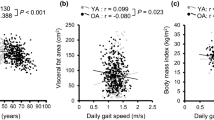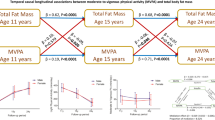Abstract
Purpose:
To investigate the association between adiposity and pedometry-assessed ambulation in a convenience sample of adult, rural black South African women.
Methods:
Pedometry data were collected over 7 days in 121 subjects. Adiposity measures included body mass index (BMI), waist circumference (WC) and percentage body fat (PBF).
Results:
Sedentarism (<5000 steps day−1) was found in 13.7%, while 39.7% were classified as accruing sufficient physical activity (⩾10 000 steps day−1). Significant associations (P<0.02) existed between steps day−1 and adiposity measures (r=−0.22 to −0.23). After adjusting for age, only BMI remained significantly associated with steps day−1 (r=−0.20, P=0.032). Significant age-adjusted linear trends were found across combined BMI–WC risk categories for steps day−1 (P=0.036). Adjusting for age, motor vehicle access, education, use of tobacco products and comorbidities, BMI decreased 1.4 kg m−2 per 5000 steps day−1 (P=0.035), access to a motor vehicle within the household increased PBF by 4% (P=0.018), and compared with sedentarism, the risk of obesity (BMI ⩾30 kg m−2) was 52% lower at 10 000 steps day−1 (P=0.028).
Conclusion:
Modest associations were found between adiposity and ambulation. Ambulation decreased the risk for obesity, while motor vehicle access was associated with increased adiposity levels.
This is a preview of subscription content, access via your institution
Access options
Subscribe to this journal
Receive 12 print issues and online access
$259.00 per year
only $21.58 per issue
Buy this article
- Purchase on Springer Link
- Instant access to full article PDF
Prices may be subject to local taxes which are calculated during checkout

Similar content being viewed by others
References
Kruger HS, Venter CS, Vorster HH, Margetts BM . Physical inactivity is the major determinant of obesity in black women in the North West Province, South Africa: the THUSA study. Transition and Health during Urbanisation of South Africa. Nutrition 2002; 18/5: 422–427.
Lambert EV, Charlton KE . Energy expenditure and habitual physical activity levels. In: Charlton KE, Wolmarans P (eds). Food Habits, Dietary Intake and health of Older Coloured South Africans. HSRC/UCT Centre for Gerontology: Cape Town, 1995. pp. 148–159.
Alberts M, Urdal P, Steyn K, Stensvold I, Tverdal A, Nel JH et al. Prevalence of cardiovascular diseases and associated risk factors in a rural black population of South Africa. Eur J Cardiovasc Prev Rehabil 2005; 12/4: 347–354.
Heyward VH, Stolarczyk LM . Applied Body Composition Assessment 1996. Human Kinetics: Champaign, IL, pp. 21–43, 66–88.
Durnin JVGA, Wormersley J . Body fat assessed from total body density and its estimation from skinfold thickness. Measurement on 481 men and women aged 16–72 years. Br J Nutr 1974; 32: 77–97.
National Institutes of Health. Clinical guidelines on the identification, evaluation, and treatment of overweight and obesity in adults-the evidence report. Obes Res 1998; 6 (Suppl 2): 51S–209S.
Bassett DR, Strath SJ . Use of pedometers to assess physical activity. In: Welk GJ (ed). Physical Activity Assessments for Health-Related Research. Human Kinetics: Champaign, IL, 2002. pp. 163–177.
Tudor-Locke C, Bassett DR . How many steps/day are enough? Preliminary pedometer indices for public health. Sports Med 2004; 34/1: 1–8.
Levitt NS, Katzenellenbogen JM, Bradshaw D, Hoffman MN, Bonnici F . The prevalence and identification of risk factors for NIDDM in urban Africans in Cape Town, South Africa. Diabetes Care 1993; 16/4: 601–607.
Kruger HS, Venter CS, Vorster HH . Physical inactivity as a risk factor for cardiovascular disease in communities undergoing rural to urban transition: the THUSA study. Cardiovasc J S Afr 2003; 14/1: 16–23, quiz.
Steyn K, Jooste PL, Bourne L, Fourie J, Badenhorst CJ, Bourne DE et al. Risk factors for coronary heart disease in the black population of the Cape Peninsula. S Afr Med J 1991; 79: 480–485.
Tudor-Locke C, Ham SA, Macera CA, Ainsworth BE, Kirtland KA, Reis JP et al. Descriptive epidemiology of pedometer-determined physical activity. Med Sci Sports Exerc 2004; 36/9: 1567–1573.
Bassett DR, Schneider PL, Huntington GE . Physical activity in an Old Order Amish community. Med Sci Sports Exerc 2004; 36/1: 79–85.
Tudor-Locke C, Ainsworth BE, Whitt MC, Thompson RW, Addy CL, Jones DA . The relationship between pedometer-determined ambulatory activity and body composition variables. Int J Obes Relat Metab Disord 2001; 25/11: 1571–1578.
Tudor-Locke CE, Bell RC, Myers AM, Harris SB, Lauzon N, Rodger NW . Pedometer-determined ambulatory activity in individuals with type 2 diabetes. Diabetes Res Clin Pract 2002; 55/3: 191–199.
Chan CB, Spangler E, Valcour J, Tudor-Locke C . Cross-sectional relationship of pedometer-determined ambulatory activity to indicators of health. Obes Res 2003; 11/12: 1563–1570.
Thompson DL, Rakow J, Perdue SM . Relationship between accumulated walking and body composition in middle-aged women. Med Sci Sports Exerc 2004; 36/5: 911–914.
Bell AC, Keyou G, Popkin BM . The road to obesity or the path to prevention: motorized transportation and obesity in China. Obes Res 2002; 10/4: 277.
Lee IM, Rexrode KM, Cook NR, Manson JE, Buring JE . Physical activity and coronary heart disease in women: is ‘no pain, no gain’ passe? JAMA 2001; 285/11: 1447–1454.
Le Masurier GC, Sidman CL, Corbin CB . Accumulating 10 000 steps: does this meet current physical activity guidelines? Res Q Exerc Sport 2003; 74/4: 389–394.
Acknowledgements
This study was supported by the Research Development and Administration Division of the University of Limpopo (Turfloop Campus) and the Institutional Research Development Programme of the National Research Foundation.
Author information
Authors and Affiliations
Corresponding author
Rights and permissions
About this article
Cite this article
Cook, I., Alberts, M. & Lambert, E. Relationship between adiposity and pedometer-assessed ambulatory activity in adult, rural African women. Int J Obes 32, 1327–1330 (2008). https://doi.org/10.1038/ijo.2008.26
Received:
Revised:
Accepted:
Published:
Issue Date:
DOI: https://doi.org/10.1038/ijo.2008.26
Keywords
This article is cited by
-
Physical activity levels and associated socio-demographic factors in Bangladeshi adults: a cross-sectional study
BMC Public Health (2017)
-
Is it Pleasure or Health from Leisure that We Benefit from Most? An Analysis of Well-Being Alternatives and Implications for Policy
Social Indicators Research (2016)
-
Comparisons of intensity-duration patterns of physical activity in the US, Jamaica and 3 African countries
BMC Public Health (2014)
-
Physical activity and sedentary behavior among adolescents in rural South Africa: levels, patterns and correlates
BMC Public Health (2014)
-
Objectively determined habitual physical activity in South African adolescents: the PAHL study
BMC Public Health (2014)



